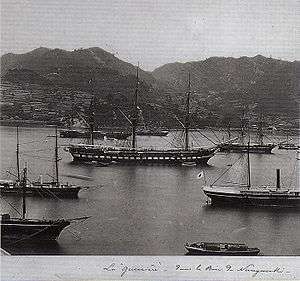French frigate Guerrière (1860)
Guerrière was a sail and steam Dryade-class frigate of the French Navy. She is known as the flagship of Admiral Pierre-Gustave Roze during the French campaign against Korea in 1866.
 Guerrière in Nagasaki harbour, 1865. | |
| History | |
|---|---|
| Name: | Guerrière |
| Namesake: | "Warrior" |
| Builder: | Brest |
| Laid down: | 8 June 1848[1] |
| Launched: | 3 May 1860[1] |
| Decommissioned: | 28 May 1888[1] |
| General characteristics | |
| Class and type: | Dryade class |
| Tons burthen: | 3600 tons |
| Propulsion: |
|
| Complement: | 475 men (230 if armed en flûte) |
| Armament: | 34 guns |
Career
Built as a 56-gun sail frigate on a design by Boucher and Masson, Guerrière was transformed by Jumboisation of steam engine section in October 1866. As such, under Captain Olivier, she became Pierre-Gustave Roze's flagship during the French campaign against Korea in 1866.[1]
In 1869, she was transformed into a troopship by addition of a second covered deck. In 1871, she was used to ferry German was prisoners after the Franco-Prussian War. The next year, under Commander Charles Boucarut, she transported prisoners of the Paris Commune sentenced to deportation to New Caledonia.[1]
In the following years, she shuttled between France and Algeria before being hulked in 1889 and broken up around 1913.[1]
A model of Guerrière is on display at the Musée national de la Marine, inside a dry dock.
 Guerrière as a hulk, photographed by Marius Bar around 1900
Guerrière as a hulk, photographed by Marius Bar around 1900 1/48th scale model of dry dock n°1 of Toulon harbour, with the model of Guerrière placed inside by order of Admiral Pâris.
1/48th scale model of dry dock n°1 of Toulon harbour, with the model of Guerrière placed inside by order of Admiral Pâris.
Notes, citations, and references
| Wikimedia Commons has media related to Guerrière (Ship, 1860). |
- Notes
- Citations
- Roche, vol.1, p.234
- References
- Roche, Jean-Michel (2005). Dictionnaire des bâtiments de la flotte de guerre française de Colbert à nos jours 1 1671 - 1870. p. 234. ISBN 978-2-9525917-0-6. OCLC 165892922.